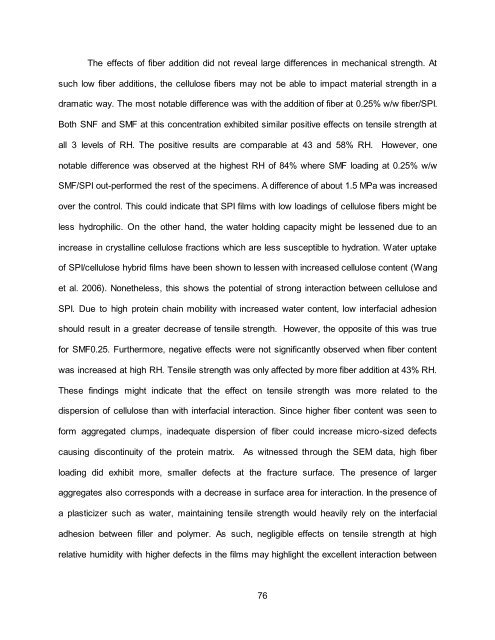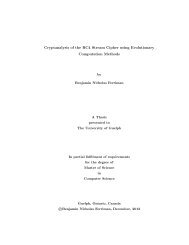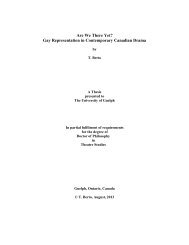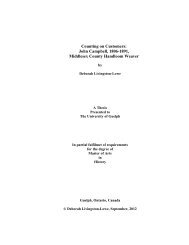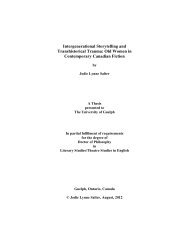THESIS - ROC CH ... - FINAL - resubmission.pdf - University of Guelph
THESIS - ROC CH ... - FINAL - resubmission.pdf - University of Guelph
THESIS - ROC CH ... - FINAL - resubmission.pdf - University of Guelph
You also want an ePaper? Increase the reach of your titles
YUMPU automatically turns print PDFs into web optimized ePapers that Google loves.
The effects <strong>of</strong> fiber addition did not reveal large differences in mechanical strength. At<br />
such low fiber additions, the cellulose fibers may not be able to impact material strength in a<br />
dramatic way. The most notable difference was with the addition <strong>of</strong> fiber at 0.25% w/w fiber/SPI.<br />
Both SNF and SMF at this concentration exhibited similar positive effects on tensile strength at<br />
all 3 levels <strong>of</strong> RH. The positive results are comparable at 43 and 58% RH. However, one<br />
notable difference was observed at the highest RH <strong>of</strong> 84% where SMF loading at 0.25% w/w<br />
SMF/SPI out-performed the rest <strong>of</strong> the specimens. A difference <strong>of</strong> about 1.5 MPa was increased<br />
over the control. This could indicate that SPI films with low loadings <strong>of</strong> cellulose fibers might be<br />
less hydrophilic. On the other hand, the water holding capacity might be lessened due to an<br />
increase in crystalline cellulose fractions which are less susceptible to hydration. Water uptake<br />
<strong>of</strong> SPI/cellulose hybrid films have been shown to lessen with increased cellulose content (Wang<br />
et al. 2006). Nonetheless, this shows the potential <strong>of</strong> strong interaction between cellulose and<br />
SPI. Due to high protein chain mobility with increased water content, low interfacial adhesion<br />
should result in a greater decrease <strong>of</strong> tensile strength. However, the opposite <strong>of</strong> this was true<br />
for SMF0.25. Furthermore, negative effects were not significantly observed when fiber content<br />
was increased at high RH. Tensile strength was only affected by more fiber addition at 43% RH.<br />
These findings might indicate that the effect on tensile strength was more related to the<br />
dispersion <strong>of</strong> cellulose than with interfacial interaction. Since higher fiber content was seen to<br />
form aggregated clumps, inadequate dispersion <strong>of</strong> fiber could increase micro-sized defects<br />
causing discontinuity <strong>of</strong> the protein matrix. As witnessed through the SEM data, high fiber<br />
loading did exhibit more, smaller defects at the fracture surface. The presence <strong>of</strong> larger<br />
aggregates also corresponds with a decrease in surface area for interaction. In the presence <strong>of</strong><br />
a plasticizer such as water, maintaining tensile strength would heavily rely on the interfacial<br />
adhesion between filler and polymer. As such, negligible effects on tensile strength at high<br />
relative humidity with higher defects in the films may highlight the excellent interaction between<br />
76


